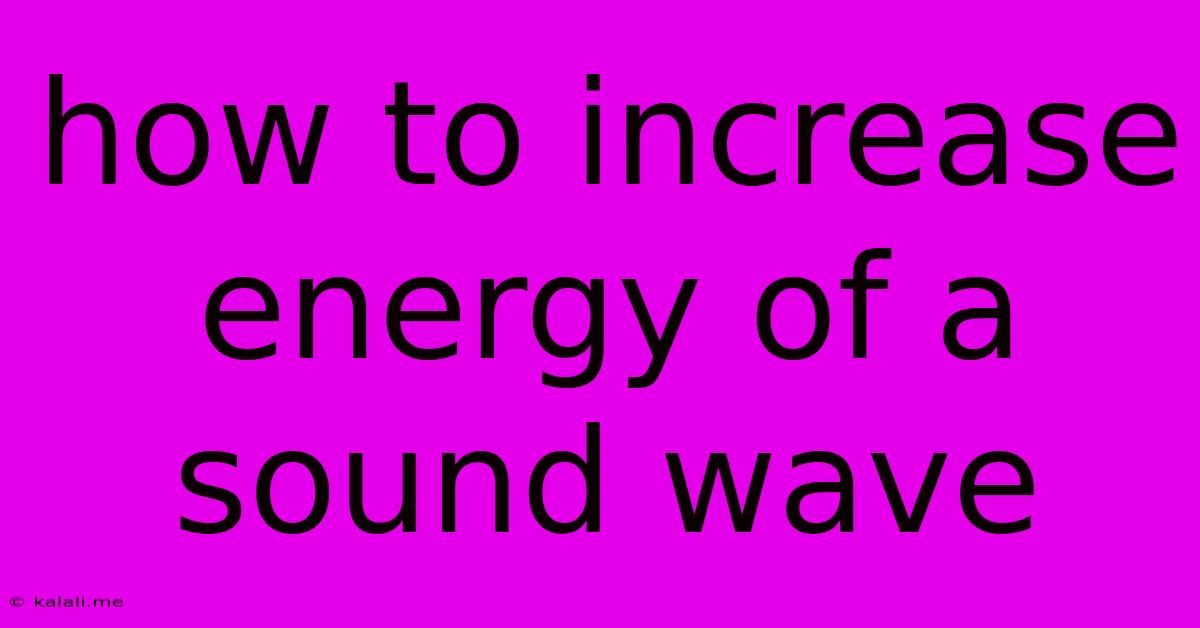How To Increase Energy Of A Sound Wave
Kalali
Jun 05, 2025 · 3 min read

Table of Contents
How to Increase the Energy of a Sound Wave
Sound, a form of energy that travels as a wave, can be manipulated in various ways. Understanding how to increase the energy of a sound wave is crucial in fields ranging from acoustics and audio engineering to medical imaging and even musical instrument design. This article will explore the fundamental principles behind amplifying sound energy. This includes discussing the factors influencing sound wave energy and practical methods for boosting its intensity.
The energy of a sound wave is directly related to its amplitude and frequency. A higher amplitude translates to a louder sound, indicating greater energy. Conversely, a higher frequency (meaning a higher pitch) doesn't necessarily mean higher energy, though it can contribute under certain conditions. Let's delve into the specifics.
Understanding Sound Wave Energy
Before we look at how to increase sound energy, it's essential to understand what determines it. The energy (E) of a sound wave is proportional to the square of its amplitude (A) and is also related to its frequency (f) and the medium through which it travels.
-
Amplitude: This represents the maximum displacement of particles from their equilibrium position as the wave passes. A larger amplitude means the particles vibrate more forcefully, resulting in a more powerful sound wave and thus greater energy. Think of it like this: a louder shout has a higher amplitude than a whisper.
-
Frequency: This measures the number of cycles (oscillations) the wave completes per unit of time (usually measured in Hertz, Hz). While a higher frequency usually correlates with a higher perceived pitch, its direct relationship with energy is less straightforward than amplitude. The energy is related to the square of the amplitude, so even at the same frequency, a larger amplitude carries more energy.
-
Medium: The properties of the medium—the substance through which the sound wave travels (like air, water, or solids)—affect sound wave propagation and energy transfer. Density and elasticity of the medium play key roles. Sound waves travel faster and with less energy loss in denser mediums.
Methods to Increase Sound Wave Energy
Now, let's explore practical methods for increasing the energy of a sound wave:
-
Amplification: This is the most common method. Electronic amplifiers utilize transistors or vacuum tubes to boost the electrical signal representing the sound wave. This stronger signal then drives a speaker, creating a sound wave with a significantly higher amplitude and therefore greater energy. Think of a microphone amplifying your voice.
-
Resonance: By designing systems that resonate at specific frequencies, you can efficiently concentrate energy at those frequencies. This is why musical instruments, like guitars or violins, have resonating chambers that amplify certain frequencies produced by the strings. The instrument's construction is designed to exploit resonance for a higher output.
-
Sound Focusing: Using acoustic lenses or parabolic reflectors, you can concentrate sound waves in a specific area, effectively increasing the intensity (and thus the energy) at the focal point. This principle is used in applications like sonar and some medical imaging techniques.
-
Increasing the source power: A more powerful sound source will naturally produce a sound wave with greater energy. Consider the difference between a whisper and a loud shout; the latter requires far more energy from the vocal cords. This applies to any sound-producing device.
-
Modifying the medium: Optimizing the medium through which sound travels can minimize energy losses. For instance, designing a concert hall with sound-absorbing materials carefully placed can lead to a higher effective sound energy in the audience area. Conversely, materials that reflect or amplify sound can improve overall energy projection.
Conclusion
Increasing the energy of a sound wave is achievable through several methods, each leveraging different principles of acoustics and physics. Understanding the interplay between amplitude, frequency, and the properties of the medium is crucial for effectively manipulating and amplifying sound. Whether in music, engineering, or medicine, controlling sound wave energy is essential for numerous applications.
Latest Posts
Latest Posts
-
How To Get Rid Of Tea Stains In Cups
Jun 06, 2025
-
Does Find My Iphone Notify The Other Person
Jun 06, 2025
-
How Long Did Lazarus Live After Jesus
Jun 06, 2025
-
Wire Gauge For Garage Door Sensors
Jun 06, 2025
-
Fallout New Vegas Joining The Ncr
Jun 06, 2025
Related Post
Thank you for visiting our website which covers about How To Increase Energy Of A Sound Wave . We hope the information provided has been useful to you. Feel free to contact us if you have any questions or need further assistance. See you next time and don't miss to bookmark.